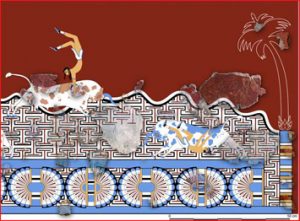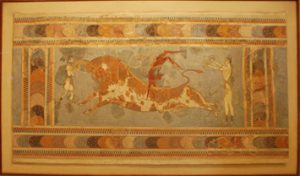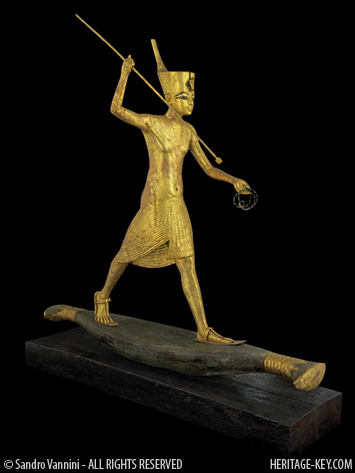One of the most perplexing mysteries that Egyptologists and Aegean experts are tackling is that of the frescoes of Tell el-Dab’a, also known as Avaris.This site was used as the capital of the Hyksos, at a time when they ruled much of Egypt, from 1640 – 1530 BC. It is on the Nile Delta and would have provided access to the Sinai, Levant and southern Egypt.
The site appears to have been abandoned for a time after the Hyksos were driven out. However, by the end of the 18th dynasty (when the Egyptians were back in control of their land), the site was in use and sported with three – yes three – large palaces. They were ringed by an enclosure wall. The whole complex was about 5.5 hectares in size.
There is no question that the frescoes at Tell el-Dab’a are Aegean influenced
Now here’s the mystery –Two of those palaces were decorated, for a very short period of time, with Minoan frescoes. These include drawings of bull-leaping scenes – which are well known from the Palace of Knossos in Crete.
Site excavator Manfred Bietak published a book in 2007 that discussed these frescoes and compared them with the more famous scenes at the Palace of Knossos.
There is no question that the frescoes at Tell el-Dab’a are Aegean influenced, and it seems likely that the artists are from Crete. Dating them is tricky but from the stratigraphy and pottery they seem to date to around the time of Thutmosis III.
What are They Doing in Egypt?

It’s an important question – but one that is difficult to decisively answer.Bietak said in his book that the paintings may symbolize the marriage of a Minoan princess into the Egyptian royal family.
“Ancient Near Eastern history is full of examples which prove that matchmaking was an important instrument of Egyptian and Near Eastern foreign politics,” he said, citing the well-known Amarna letters.
Another idea, which Bietak brings up, is that the frescoes may have been painted for the purpose of a state visit of Minoan leaders to Egypt. This is backed up by excavation which reveals that the paintings appear to have fallen off the walls after a short period of time – possibly only a few years.
These ideas certainly have quite a ring to them – a royal marriage with special painters? An ancient international summit? It sounds like the stuff of legend.
Now there’s a new idea emerging – one that is decidedly lacking in romance.
Unemployed Minoan Artists

At a lecture a few weeks ago in Toronto Professor Maria Shaw,of the University of Toronto, proposed her own theory. Shaw has done extensive archaeological work in Crete so her background is more from the Aegean side of the coin.She believes that the frescoes were drawn by out of work Minoan artists – who travelled to Egypt as the Minoan civilization was declining.
Professor Shaw’s argument works like this-
Cretan rulers controlled their art extremely carefully. Shaw said that the bull-leaping scenes are a symbol of the Palace of Knossos and are found nowhere else on the island. “I stress in no other palaces,” she said.
Also half-rosettes, the flowery decoration seen on the scenes at Tell el-Dab’a, are “a sign of royalty… it’s amazing that it was appropriated and used at Tell el-Dab’a.”
Given that the bull-leaping and half-rosette symbols were tightly controlled on Crete, it makes no sense that the rulers would let their artists paint them in a foreign country.

So, again, what are they doing in Egypt?Shaw believes that the paintings date to a time when the Palace of Knossos was in decline (ca. 1400 BC). The artists that worked there would have found themselves out of work and needing a new benefactor. “Artists must have left from there and went find jobs in Egypt,” said Shaw.
Also, as the Palace of Knossos declined so did the willingness to honour its symbols of rule.
“The respect or fear that people had not to imitate Knossos – went with Knossos,” said Shaw.
It’s also no surprise that Egyptian rulers would sanction the use of Minoan art.
Egypt at that time was open to foreign influences. The Amarna letters show that Egypt was wheeling and dealing diplomatically in the Near East. Paintings have been found showing people from the Aegean bringing gifts to Egypt. Minoan motifs have also been found in Egyptian tombs.
“There was an interest in Egypt of things Minoan,” said Shaw.
Further backing up her point is evidence from the site of Mycenae in Greece. Fragments of a bull leaping scene, similar to those found at Knossos, have been found there as well – further proof that when Knossos fell, its art and artists travelled far and wide.




